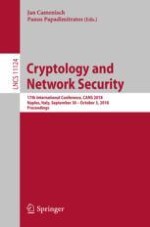2018 | OriginalPaper | Buchkapitel
Towards Video Compression in the Encrypted Domain: A Case-Study on the H264 and HEVC Macroblock Processing Pipeline
verfasst von : Donald Nokam Kuate, Sebastien Canard, Renaud Sirdey
Erschienen in: Cryptology and Network Security
Aktivieren Sie unsere intelligente Suche, um passende Fachinhalte oder Patente zu finden.
Wählen Sie Textabschnitte aus um mit Künstlicher Intelligenz passenden Patente zu finden. powered by
Markieren Sie Textabschnitte, um KI-gestützt weitere passende Inhalte zu finden. powered by
Abstract
Cingulata, SEAL and TFHE. On the other hand, we apply this to image compression in the encrypted domain, being the first to “crypto-compress” a full encrypted photograph with practically relevant performances.